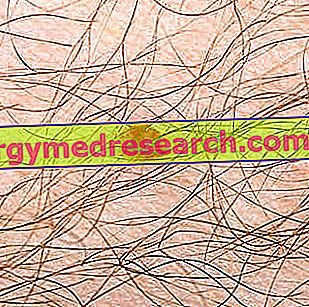Generality
A ruby angioma is a benign tumor, cutaneously located, which originates from an endothelial cell of a blood vessel; at sight, it looks like a patch or a red-purple colored papule with small dimensions (it generally varies between 3 and 5 millimeters; rarely it reaches centimeters).

Ruby angiomas are typically asymptomatic presences without danger, so much so that, unless they represent an imperfection, they are not subjected to any removal / elimination treatment.
Brief reminder of what an angioma is
In medicine, the term angioma identifies a type of benign tumor that originates from a cell of the inner wall (endothelial cell) of a blood vessel or lymphatic vessel.
What is a ruby angioma?
The ruby angioma is a particular variety of angioma, which originates from an endothelial cell of a blood vessel and has a typical cutaneous location (ie on the skin).
Ruby angiomas are presences generally devoid of danger and must not cause particular apprehensions, unless they suddenly change their appearance.
In the course of life, a human being can develop more than one ruby angioma.
Ruby hemangioma is also known as senile angioma or angioma of Campbell de Morgan.
Ruby angioma is a hemangioma
The ruby angioma is a hemangioma ; "Hemangioma" is the most appropriate medical term for defining any angioma deriving from an endothelial cell of a blood vessel.
To be even more precise, the ruby angioma is a capillary hemangioma .
Curiosity: what are the other subtypes of hemangioma?
Capillary hemangioma is only one of three possible subtypes of existing hemangioma; the other two subtypes are the so-called cavernous hemangioma and the so-called pyogenic granuloma .
Characteristics of a typical ruby angioma
A typical ruby angioma is a dense agglomeration of capillaries and slightly larger blood vessels, which can have the appearance of a blotch or a papule, it can be red or purple, it can have a circular or oval shape and, finally, it can be smooth or detected.
As far as size is concerned, ruby angiomas can measure from a few millimeters (3-5 at most) to almost one centimeter (rare).
Where do ruby angiomas usually form?
Although it can develop in any skin area of the human body, the ruby angioma has a particular preference for the trunk, arms, legs and shoulders.
Epidemiology
Ruby angiomas represent the most widespread type of angioma.
They do not have preferences for a particular breed, they equally affect men and women, and tend to form especially in old age.
Curiosity: how widespread is the ruby angioma among the elderly?
According to a statistical study, more than 75% of people over the age of 75 would carry at least one ruby angioma.
Synonyms
The ruby angioma is known by several other names, including:
- Cherry angioma
Reason: the color of the ruby angioma resembles the purplish-red coloration of a typical cherry.
- Senile angioma
Reason: because, as mentioned above, the ruby angioma is particularly common among people of advanced age.
- Stain of Campbell De Morgan
Reason: Campbell De Morgan is the surname of the British surgeon who described for the first time, in the 19th century, the ruby angioma.
Causes
A ruby angioma is the result of a proliferative process which, starting from an endothelial cell of a blood vessel, leads to the formation of an agglomeration of capillaries and blood vessels .
Currently, despite numerous studies conducted on the subject, the causes of the aforementioned proliferative process (therefore, in fact, the causes of ruby angioma) are unknown and represent a true mystery.
Are there any suspicious causes? What are they?
The hypothesized causes of ruby angioma include: genetic factors, pregnancy (clearly in women), persistent exposure to sunlight, prolonged exposure to certain chemicals, repeated intake of some drugs (eg cyclosporine or bromides) ), certain medical conditions (eg: liver or intestine diseases) and particular climatic conditions.
Symptoms and complications
The ruby angioma is generally an asymptomatic presence, ie without symptoms.
However, it is important to point out that, if it is the object of cuts, abrasions or scratches, it can become bleeding .
On what occasions is it better to consult a doctor?
The ruby angioma passes from a non-worrying condition to the condition of a dermatologist, when he is the protagonist of a sudden enlargement; in fact, such a modification could be indicative of its malign evolution .
Fortunately, the transformation into a malignant tumor by a ruby angioma is a very rare event indeed.

See more Photos of Angioma Senile
Diagnosis
The diagnosis of ruby angioma is based on the simple observation of the skin, specifically the cutaneous area affected by the patch or the red-purple papule.
As a rule, the identification of ruby angiomas is within the capabilities of any doctor, so it is not necessary to address a dermatologist exclusively.
Therapy
Generally, the ruby angioma does not need any treatment ; however, if an individual sees it as an uncomfortable presence (or because it represents an imperfection or because it is the cause of bothersome bleeding ), it can safely ask a dermatologist for its removal.
Currently, there are several procedures to eliminate ruby angiomas; among these procedures, the most important are:
- The electrocautery;
- Cryosurgery;
- Laser surgery;
- Excision by curettage.
electrocautery
Electrocautery involves the "burning" of the ruby angioma, through the electric current supplied by a special probe of reduced dimensions.
The electrocautery procedure, therefore, is based on the use of electricity.
cryosurgery
Cryosurgery involves the destruction of the ruby angioma by freezing; to carry out the freezing, doctors use liquid nitrogen.
Cryosurgery is a quick and relatively simple solution; the resulting wound heals, generally, in a short time.
Laser surgery
Laser surgery involves the elimination of the ruby angioma by pulsed laser ; this particular laser acts, in fact, burning the skin area presenting the anomaly to be removed.
Laser surgery is an outpatient procedure, so it does not require hospitalization.
Sometimes, its use can cause some bruises on the skin, which disappear within 7-10 days.
Excision by scraping
The excision through scraping of the ruby angioma consists in the elimination of the latter by means of a special instrument, called curette, which is comparable to a spoon with sharp edges.
Scraping excision represents the alternative to the traditional surgery intervention aimed at eliminating ruby angiomas; intervention, the one just mentioned, definitely more invasive and now less and less in use.
Prognosis
As stated, the presence of a ruby angioma is not usually a threat to human health.
In order to be able to count on an adequate elimination of a ruby angioma, it is advisable to contact a qualified dermatologist and an expert in the field.



